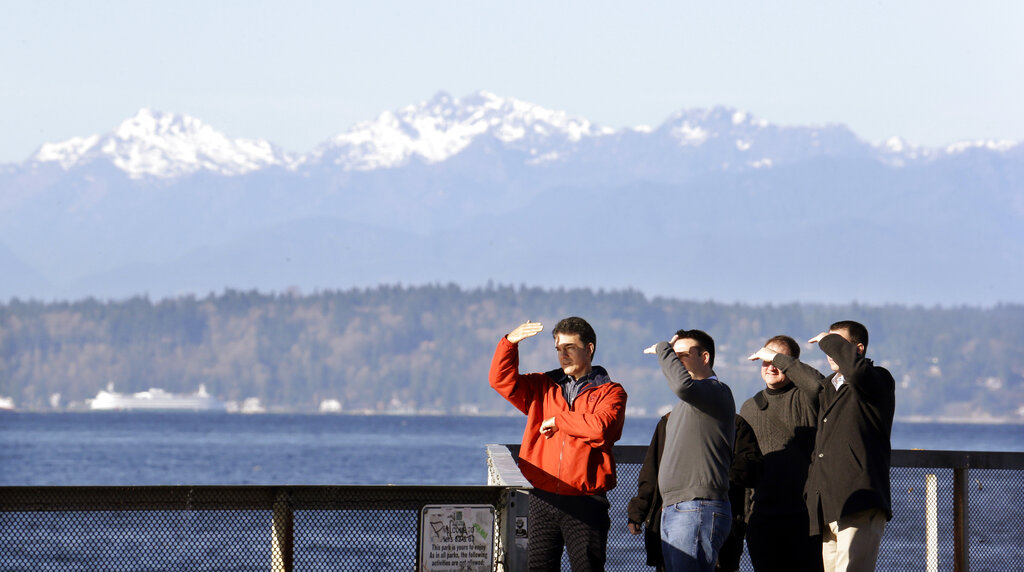SEATTLE — Not since 2015 has Washington’s snowpack fallen so far below normal.
Some regions of the state are preparing for another drought this summer. Others are still enmeshed in the drought that began last summer.
No place embodies Washington’s distinct lack of snow as much as the Olympic Peninsula, which has just half of what could be considered normal snowpack. And the area is already rumbling with fresh talk of likely water restrictions for the months ahead.
A spate of recent snowstorms did help but not enough and little additional help appears to be on the way before April 1, generally accepted as the peak of the winter snowpack.
“Even if we had a miracle March it would take a lot of snow to get us to normal,” said Caroline Mellor, water resources statewide drought lead for the state’s Department of Ecology.
How bad is it?
It’s pretty lousy. The worst in nearly a decade but Washington’s still in better shape than it was in 2015, which state climatologist Nick Bond said is the worst on record.
On this date in 2015 the vast majority of the state had less than 50% of what would be considered a normal snowpack and many places fell below even 25% of normal, according to data collected by the U.S. Department of Agriculture’s Natural Resource Conservation Service.
This year Puget Sound watersheds are hovering between 64% and 71% of normal. The Columbia River basin sits between 68% and 86% of normal and the Yakima spans between 61% and 82% of normal, Conservation Service data shows. The lower Snake River, around Walla Walla is in the best shape with about 90% of normal snowpack. And the Olympic Peninsula is faring the worst with 51% of normal snowpack.
Low snowpack means less water for rivers and streams across the state, less water for people, for crops, for utilities generating electricity, for fish like salmon and for the rest of the plants and animals that call the Pacific Northwest their home.
Not only do experts and public officials find the dwindling snowpack concerning but they also worry about increasing spring temperatures, which cause it to melt earlier than expected.
The weather over the next few months will help determine conditions throughout the entire summer.
“Spring matters,” Bond said. “It can giveth and it can taketh away.”
Drought emergency
Water was in such short supply last summer that communities on the Olympic Peninsula faced mandatory water restrictions to save the resource. Seattle Public Utilities opted for voluntary restrictions. At its reservoirs, Seattle City Light wasn’t able to produce enough electricity to meet demand so it burned through more than $70 million in emergency reserves forcing a rate hike to compensate.
By early July Ecology declared a drought advisory across the entire state and by the end of the month it followed up by announcing a drought emergency across 12 counties. The declaration unlocks state funding and expedites help for governments requesting it, Mellor said.
The drought emergency is still in effect, it will expire June 30, though Mellor said her team is consistently watching to see if they should extend the declaration through the summer.
“We have a high probability of above-average temps and below-average precip over the next three months,” she said. “That definitely has us highly concerned.”
Even the rosiest predictions show rivers like the Elwha and Dungeness will still only flow with around 80% of their normal water levels, said Brent Bower, a hydrologist with the National Weather Service.
People across the peninsula are bracing for additional water restrictions, said state Rep. Mike Chapman, D-Port Angeles. This year’s drought “looks like one of the worst we may have ever seen,” he said.
Climate change is compounding the effects of these droughts year after year, Port Angeles City Council Member LaTrisha Suggs said in an email.
The Elwha is the sole water supply for around 25,000 people, Suggs said, and perhaps residents need to be warned to conserve water ahead early rather than waiting until the supply is low.
On the Dungeness the Jamestown S’Klallam Tribe is preparing for the worst, said Hansi Hals, director of the tribe’s Natural Resources Department. The river hit historic lows last year, spelling trouble for Chinook salmon and other fish species.
But the tribe cast a wide net with its partners on a state and local level and saw major success, Hals said. Some water users agreed to draw less water from the river, easing the pressure. Others agreed to coordinate periods where they’d stop drawing water for several hours at a time to boost the river’s flows. Others still worked on site, using rocks to channel and pool water at different places on the river.
The effort worked, Hals said. Chinook surpassed the tribe’s recovery goal for returning adults.
Now, though, the tribe and its partners have to do it all over again, Hals said. They’re getting used to the process, fine tuning it where they can, because these types of low-stream flows are likely to be the normal 30 years from now.
Another alarming trend for the peninsula is the ongoing disappearance of glaciers across the Olympics, shifting the watersheds in the region toward a rain-dominant supply of water, said Anne Shaffer, executive director of the Coastal Watershed Institute in Port Angeles.
“What happens when we go from glaciers, which are so consistent, to rain, which isn’t?” she said.
Bond noted that La Niña conditions might bring a bit of respite but the cool, wet weather it’s expected to bring won’t begin until the next wet season, so we’ll have to make it through this summer first.



